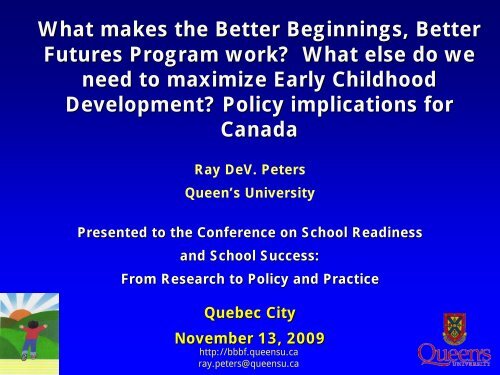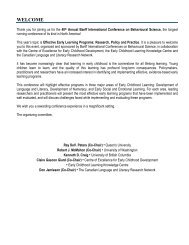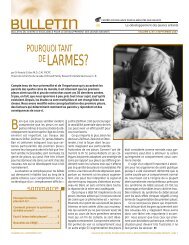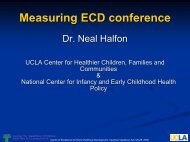What Makes the Better Beginnings, Better Futures Program work?
What Makes the Better Beginnings, Better Futures Program work?
What Makes the Better Beginnings, Better Futures Program work?
You also want an ePaper? Increase the reach of your titles
YUMPU automatically turns print PDFs into web optimized ePapers that Google loves.
<strong>What</strong> makes <strong>the</strong> <strong>Better</strong> <strong>Beginnings</strong>, <strong>Better</strong><strong>Futures</strong> <strong>Program</strong> <strong>work</strong>? <strong>What</strong> else do weneed to maximize Early ChildhoodDevelopment? Policy implications forCanadaRay DeV. PetersQueen’s UniversityPresented to <strong>the</strong> Conference on School Readinessand School Success:From Research to Policy and PracticeQuebec CityNovember 13, 2009November 13, 2009http://bbbf.queensu.caray.peters@queensu.ca
OBJECTIVES OFPRESENTATION1. To describe what <strong>work</strong>ed and what didnot <strong>work</strong> in <strong>the</strong> <strong>Better</strong> <strong>Beginnings</strong>, <strong>Better</strong><strong>Futures</strong> project.2. To discuss <strong>the</strong> implications of <strong>the</strong>seresearch findings for Early ChildhoodDevelopment policy in Canada.
TECHNICAL ADVISORYGROUPIn 1988, <strong>the</strong> Ontario Governmentconvened a Technical AdvisoryGroup of program experts andresearchers to carry out aninternational review of successfulprevention and promotion programsfor young children.
BETTER BEGINNINGS, BETTER FUTURES:AN INTEGRATED MODEL OF PRIMARY PREVENTION OFEMOTIONAL AND BEHAVIOURAL PROBLEMS© Queen’s Printer for Ontario, 19905M/3/90ISBN 0-7729-6148-4
There are limitations to currentknowledge regarding effectiveintervention programs.• Most effective demonstrations are small scale(involving less than 100 families)• Little is known about <strong>the</strong> effects of expanding <strong>the</strong>sedemonstration programs to larger groups• Costs of implementing programs are seldom collectedor reported. This makes it difficult for policy makersto make informed decisions• There are a few projects which have carried outquality economic analyses. However, again, <strong>the</strong>seprojects have had small sample sizes, makingextrapolations to large-scale implementations difficult
There is much rhetoric about <strong>the</strong>importance of programs beingcomprehensive, ecological,holistic, community-based,collaborative and/or integrated• However, <strong>the</strong>re are virtually no wellresearchedprograms for young childrenwhich have successfully incorporated<strong>the</strong>se characteristics into <strong>the</strong> programmodel
Ecological Model of Child DevelopmentSOCIETYvaluespeersNEIGHBOURHOODPARENT/FAMILYschoolsocialpolicymassmediasocial,health,andparentsCHILDphysicalsocial/emotionalcognitiveextendedfamilylegalservicessiblingsclubsfriends offamily
<strong>Program</strong>s and Evaluations needto be more ecological.• Consider development of “whole child” –physical, social, behavioural, cognitiveand emotional development and wellbeing• Parent and family functioning andcharacteristics• Neighbourhood characteristics and change
It was in this social policycontext that <strong>the</strong> Ontario,Canada provincial governmentannounced <strong>the</strong> <strong>Better</strong><strong>Beginnings</strong>, <strong>Better</strong> <strong>Futures</strong>Project in 1990.
<strong>Better</strong> <strong>Beginnings</strong>, <strong>Better</strong> <strong>Futures</strong>Purpose:A 25-year longitudinal preventionpolicy research demonstrationproject to provide information on<strong>the</strong> effectiveness of prevention asa policy for children.
Younger Child Sites (0 - 4 yrs)Guelph:Kingston:Ottawa:Toronto:Willow Road• 500 childrenNor<strong>the</strong>rn Area• 876 childrenAlbion-Hea<strong>the</strong>rington• 552 childrenRegent Park• 900 childrenWalpole Island First Nation:• 200 childrenOlder Child Sites (4 - 8yrs)Cornwall: 4 Francophoneprimary schools• 530 childrenEtobicoke: Highfield JuniorSchool• 517 childrenSudbury:Flour Mill / leMoulin à Fleurand Donovan• 503 children
PROJECT BUDGET & CHILD POPULATIONYOUNGER CHILD SITES96/97 BUDGET # CHILDRENGuelph $ 499,992 500Kingston $ 723,559 876Ottawa $ 515,979 552Toronto $ 710,512 900Walpole Is. $ 325,857 200ALL SITES $2,775,899 3,028OLDER CHILD SITESCornwall $ 580,938 529Highfield $ 512,166 517Sudbury $ 657,942 503ALL SITES $1,751,046 1,549
BOTTOM-UP PROGRAMDEVELOPMENT APPROACHEach community to undertake asmany high quality programs aspossible, which could be expected toproduce positive child developmentoutcomes, within <strong>the</strong> limits ofavailable resources and local needs.
CHILD PROGRAMS AT OLDER SITES• In-class and in-schoolprograms• Child care enhancements• Before and after-schoolactivities• School “breakfastclub”• Recreation programs
CHILD PROGRAMSAT YOUNGER SITES• home visiting• child care enhancements• playgroups• parent and child drop-in• parent “take-a-break”• parent and infant group
FAMILY HEALTH &SUPPORT PROGRAMS• parent support groups• parenting <strong>work</strong>shops• one-on-one support• food, clothing & infantemergency supplies• adult education• ESL programs• family camps• outreach tofamilies
COMMUNITY DEVELOPMENTPROGRAMS• community leadership development• special community events and celebrations• safety initiatives in <strong>the</strong> neighbourhood• community field trips• community gardens & co-op food purchasing• youth recreation programs• youth leadership training
PROGRAMS OFFEREDYounger Sites: Average = 26Range = 18-35Older Sites: Average = 16Range = 12-19
<strong>Better</strong> <strong>Beginnings</strong>, <strong>Better</strong> <strong>Futures</strong>:Overall Project Organization8 <strong>Better</strong> <strong>Beginnings</strong>Project SitesGovernmentCommitteeResearchCoordinationUnit
Planning Phase (1991-1993)Community residents, service-provider partners, andstaff designed a comprehensive, ecological programmodel.Demonstration Phase (1994-1998)Project provided five years of intervention for childrenfrom birth to age 4 and <strong>the</strong>ir families in 5 sites(younger child sites) and for children 4 to 8 years ofage and <strong>the</strong>ir families in 3 sites (older child sites).
Research Questions1. How do <strong>the</strong> <strong>Better</strong> <strong>Beginnings</strong> communitiesdevelop and implement programs? Are <strong>the</strong>ycharacterized by:• Parent and community involvement?• Integration of services?• High quality programs?Project Development & <strong>Program</strong> Model Research
Research Questions2. Are <strong>the</strong> <strong>Better</strong> <strong>Beginnings</strong> programs effectivein:• Preventing serious problems in young children?• Promoting healthy child and family development?• Enhancing <strong>the</strong> abilities of disadvantagedcommunities to provide for children and <strong>the</strong>irfamilies?Outcome Evaluation Research
Research Questions3. <strong>What</strong> are <strong>the</strong> annual costs of <strong>the</strong>seprograms?Economic Analysis Research
Research Questions4. <strong>What</strong> are <strong>the</strong> long-term effects and cost-benefits forchildren and <strong>the</strong>ir families in terms of:• Educational achievements and high schoolgraduation rates?• Use of special education, health, and socialservices?• Employment and social assistance?• Criminal charges and convictions?• Teen pregnancy?• Drug and alcohol abuse?Long Term Follow-up Research
Research QuestionsThe first three questions are addressed byresults of <strong>the</strong> research on <strong>the</strong> DemonstrationPhase of <strong>the</strong> Project (1993-1998) in a “ShortTerm Findings Report”. http://bbbf.queensu.caThe fourth question is being answered in followupresearch of <strong>Better</strong> <strong>Beginnings</strong> children as<strong>the</strong>y develop into adolescence and beyond.
Data Collection<strong>Program</strong> funding of <strong>the</strong> eight sites began in April of1991. It took 2½ years for local projects andprograms to develop to <strong>the</strong> point where valuationscould begin in <strong>the</strong> fall of 1993.Extensive information was collected and reported by<strong>the</strong> Research Coordination Unit on “start up”processes.Baseline measures on children, families, andneighbourhoods were collected in 1992-1993.
Data Collection (continued)In 1993-94, a longitudinal research group of 1,400children and <strong>the</strong>ir families was recruited in 8 projectand 3 comparison sites.Outcome measures were collected on <strong>the</strong>sechildren/families for 5 years.During this 5 year period, information wasalso collected regularly on:• Project organization • Service integration• Local programs • <strong>Program</strong> costs• Resident participation
LONGITUDINAL FOLLOW-UP OFCHILDREN IN GRADES 1 AND 3FROM THE YOUNGER SITES• 531 children of <strong>the</strong> families from <strong>the</strong> 5younger child <strong>Better</strong> <strong>Beginnings</strong>neighbourhoods• 164 children of <strong>the</strong> families from <strong>the</strong>comparison neighbourhoods
Outcome Measures Collected at Grades 1and 3DomainNo. of MeasuresAnalyzedChild Prosocial Behaviour 6Child Emotional & Behavioural Problems 10School Performance 13Child’s Physical Health 6Parent Health 4Parent Social/Emotional Functioning 6Parenting 3Neighbourhood Quality & Involvement 12TOTAL 60 X 2 = 120
FINDINGS• 9 significant differences across <strong>the</strong> sites, 7.5 %• 3 favored <strong>Better</strong> <strong>Beginnings</strong>• 6 favored Comparison Sites• Similar to CCDP outcomes (St. Pierre et al, 1997)
WHY SUCH NEGATIVEFINDINGS?• Mandate of <strong>Better</strong> <strong>Beginnings</strong>,<strong>Better</strong> <strong>Futures</strong> too broad• Resources too few
Costs of Model <strong>Program</strong>s for Very YoungChildren (0 to 4) and <strong>the</strong>ir Families<strong>Program</strong> NameAverage Cost perchild per yearNumberof yearsTotal <strong>Program</strong>Cost per ChildAbecedarian * $20,000 5 $100,000IHDP * $23,582 3 $ 70,747CCDP $10,800 5 $ 54,000Early Head Start $10,100 3 $ 30,300Perry Preschool* $15,069 2 $ 30,138Chicago Child-Parent Centers * $ 7,617 2 $ 15,234Nurse Home Visitation * $ 5,250 2.5 $ 13,125Sure Start $ 2,357 4 $ 9,428<strong>Better</strong> <strong>Beginnings</strong>, <strong>Better</strong> <strong>Futures</strong> $ 1,300 4 $ 5,200Note: All dollar values are in 2005 Canadian dollars.* Indicates programs with at least one significant long-term positive effect.
Why such a difference inlong-term effects in youngerversus older child programsites?
•Older child sites organizedaround <strong>the</strong> school•No such universal systemavailable for children 0-40
Average Costs of Public Education in OntarioAverage Cost perchild per yearNumberof yearsTotal <strong>Program</strong>Cost per ChildOntario Kindergarten $ 3,200 2 $ 6,400Ontario Primary School $ 6,400 8 $ 51,200Ontario Secondary School $ 8,100 4 $ 32,400Total Public Education Age 4-18 14 $ 90,000Note: All dollar values are in 2005 Canadian dollars.
Rates of Return to Human Capital Investment Initially SettingInvestment to be Equal Across All Ages. Source: Heckman (2000).
Importance of early childhood developmentInvest in <strong>the</strong> Very YoungJAMES J. HECKMAN, PhD2000 Nobel Laureate in Economic SciencesHenry Schultz Distinguished Service Professor ofEconomics, University of Chicago, USA
Where Are We Now?Uncoordinated, Sector-Specific Specific ECD ServicesProvincial-LevelAgencies$ $ $ $ $HealthCareChildcare& EarlyEducationSocio-EmotionalHealthParentEducationFamilySupportCounty-LevelAgenciesHC ECE SEH PE FSCommunity<strong>Program</strong>s
Where Are We Going?A Community Platform-Based ECD Service SystemProvincial-LevelAgencies$HealthCareChildcare& EarlyEducation$$ $ $Socio-EmotionalHealthParentEducationInter-Agency Coordinating CouncilFamilySupportCounty-LevelHC ECE SEH PE FSLocal Coordinating CouncilCommunity-BasedPlatformsfor Services
High Quality Early ChildhoodDevelopment <strong>Program</strong>s&Effective Parentingcan have a profound impact ondeveloping <strong>the</strong>se core capacitiesearly in life.
Early learning and child care:How does Canada measure up?International comparisons using data fromStarting Strong II(Organisation for EconomicCo-operation and Development, 2006)
Figure 1. Employment rates of mo<strong>the</strong>rswith children 0-6 years
Figure 2. Percent of children livingbelow <strong>the</strong> poverty line
Figure 3. GDP per capita (in U.S. $)
Figure 4. Public spending on ELCCprograms for children 0-6 as a % of GDP
Figure 5. Costs to parents for ELCC programs
Figure 6. Percent of children 0-3 yearsin regulated ELCC programs
Figure 7. Rate of access to ELCCprograms for 3-6 year olds
Coverage: Regulated child care spaces byprovince/territory and percentage ofchildren (0-5) for whom <strong>the</strong>re is a regulatedchild care space – 2006Centre-based fullandpart-day childcare for 0-5Children 0-5 forwhom <strong>the</strong>re is aregulated child carespace (%)Ontario 138,979 16.9Canada 387,562 19.3
Expenditures on earlychildhood programs in OECDcountries range from about0.2% to 2% of GDP
Canada is at <strong>the</strong> lowest end spendingabout 0.2%. The European Unionrecommends its member statesdevote at least 1% of GDP to earlychildhood services. For Canada thisrepresents about $10 billion.
If spending in early childhoodequaled <strong>the</strong> cost per child inprimary school ($7,600), about$10 billion in new spendingwould be required.
A substantial investment in early childdevelopment will be necessary if we areto improve <strong>the</strong> competence, health andwell-being of our population.-Fraser Mustard
“It is important in my view that a governmentinstitution (or municipal institution) be given<strong>the</strong> mandate and authority to organize ECDwith a clear performance criterion – and that isto raise readiness-to-learn scores for six-yearolds.”-David Dodge, Bank of Canada
Vulnerable Children by Household Income:Canadian NLSCY(J. D. Willms [ed.], Vulnerable Children, 2002)Percent with oneor m ore (of five)problems abovecut-off35302520151050Bottom Q 3Q 2Q Top QIncome Quartiles
“access to high- quality andaffordable care and learningenvironments should be a right andentitlement for all children, ra<strong>the</strong>rthan a privilege”.-The Standing Senate Committee on Human Rights
Canadian Parents ofYoung ChildrenInvest in Kids (2002)Survey of 1600 parentsWith children 0-6 years old
Figure 1. Employment rates of mo<strong>the</strong>rswith children 0-6 years
Invest in Kids Survey (2002)The Good News:• > 90 % think parenting is <strong>the</strong> mostimportant thing <strong>the</strong>y do.• > 80% agreed with “The influence ofparents during a child’s early developmentis absolutely critical to <strong>the</strong> way a child turnsout as an adult”
Invest in Kids Survey (2002)The Bad News:• Many reported using hostile/ineffectiveparenting practices.• < 50% thought it was important to provide astimulating, sensitive environment to <strong>the</strong>iryoung children.
Invest in Kids Survey (2002)• Most parents reported little confidence orknowledge in how to influence <strong>the</strong>ir child’ssocial and emotional development.• Before first baby was born 44% of parentsfelt prepared for parenthood.• After baby’s birth, 18% felt confident asparents.
Invest in Kids Survey (2002)These low levels of confidence andknowledge applied equally to allsocio economic status groups,mo<strong>the</strong>rs and fa<strong>the</strong>rs, single and twoparent families
Invest in Kids Survey (2002)• After birth of first child, 45% of parents felt<strong>the</strong>y did not receive enough emotional orpractical support as parents.• 58% of new parents disagreed with <strong>the</strong>statement: “I think Canada values its youngchildren.”
• Why this disconnect in parents betweenperceived importance of parenting andparents’ feelings of low knowledge,confidence and support?• The very few parenting classes in Canadaare for problem children or parents in <strong>the</strong>child welfare system.• No universal, high quality parentingsupports in Canada.
<strong>What</strong> would an ideal ELCC system entail?• Maternal/Parental leave for all families with aninfant from birth to 18-24 months. Currently,leave is from birth to 1 year for some parents inCanada.* 1.5/2 to 4 years of high quality, universallyaccessible early learning and care centres,located in neighbourhood centres preferablyprimary schools.• Also schools function as a neighbourhood “hub”for child and parent supports.
<strong>What</strong> would an ideal ELCC system entail?• 4-5 years full-time, optional kindergarten• 4-12 years before and after-school, holiday andsummer programs.
The test of <strong>the</strong> moralityof a society is what itdoes for its children.- Dietrich Bonhoeffer (1906-1945)1945)
















